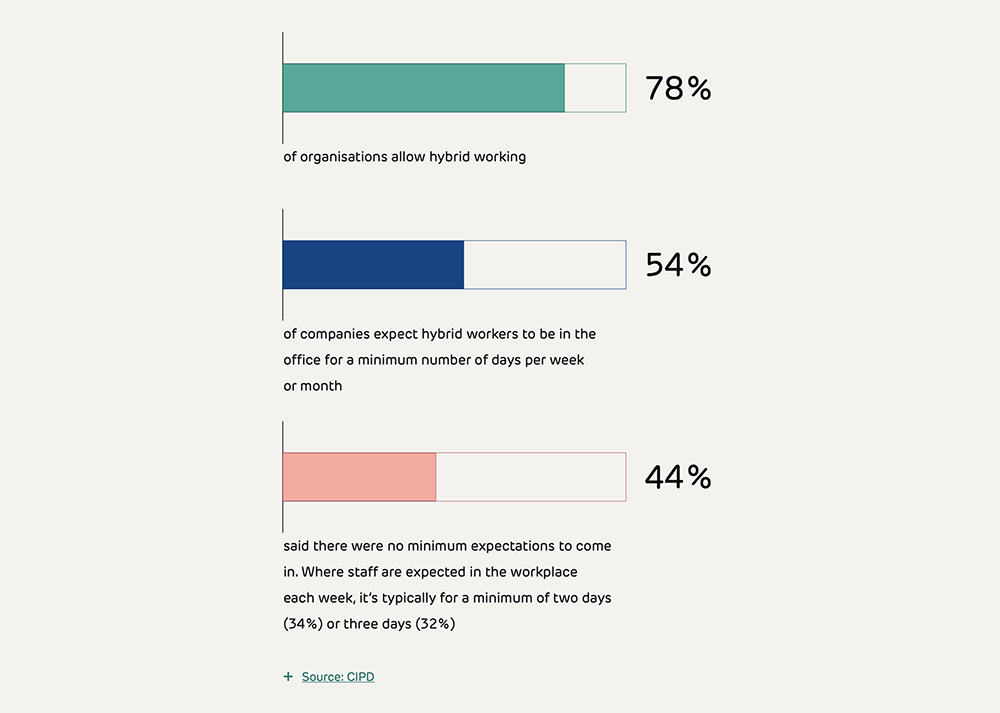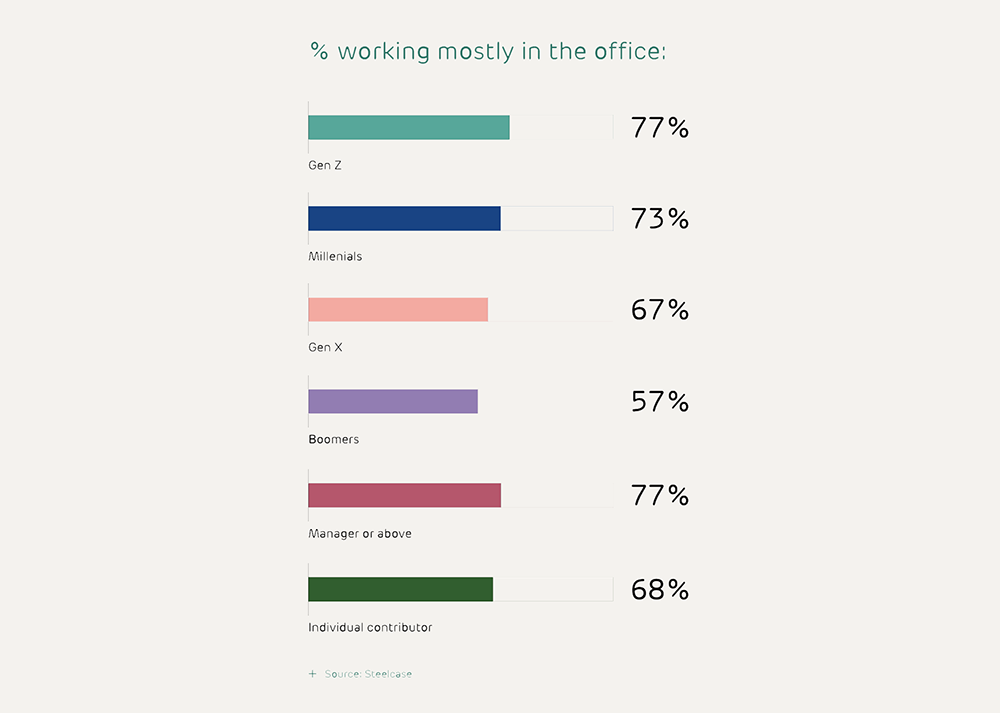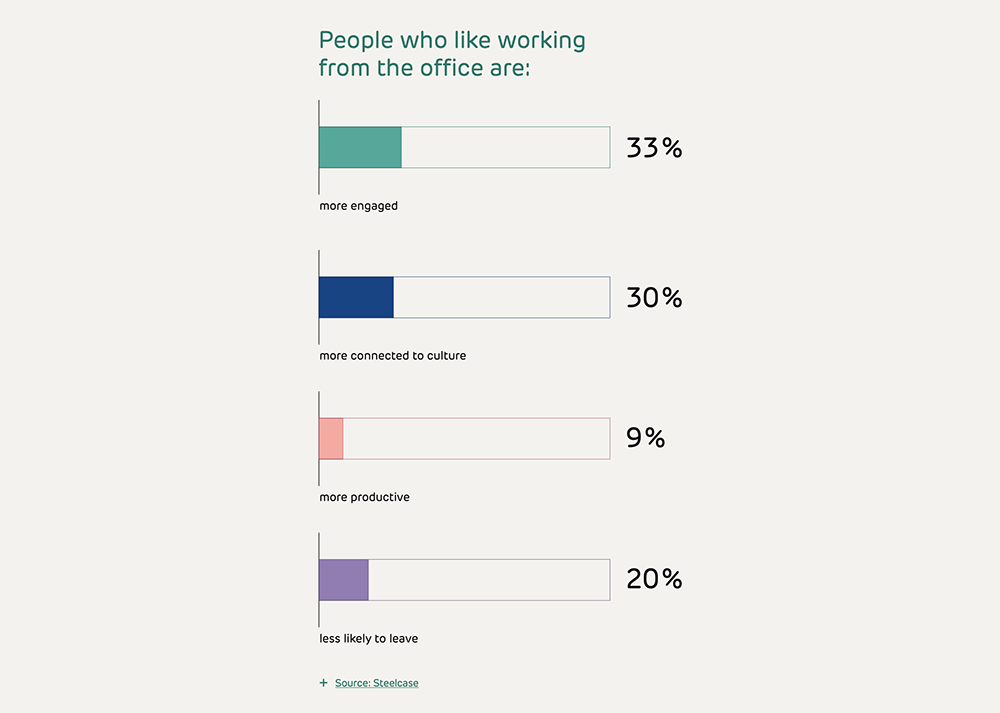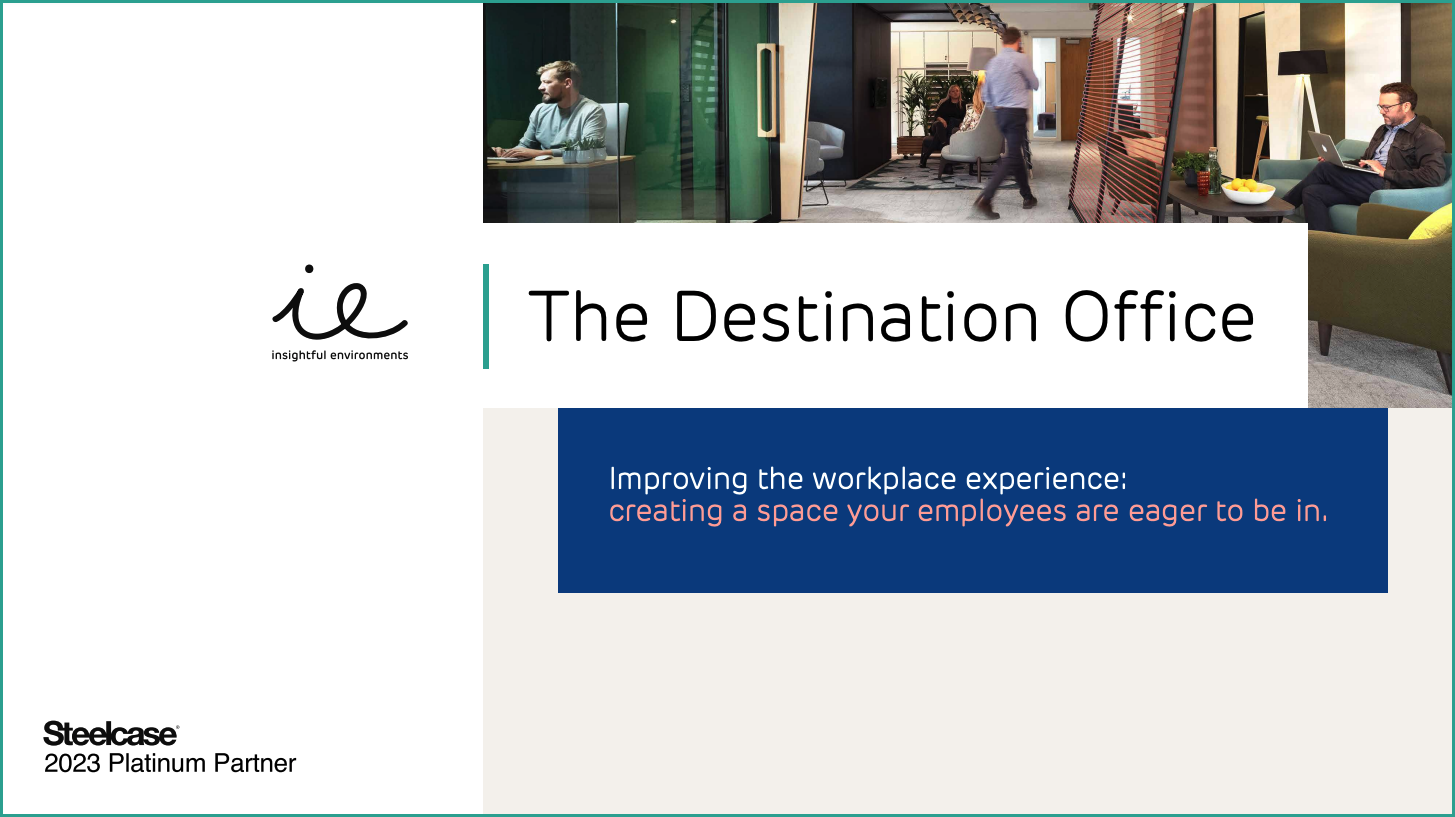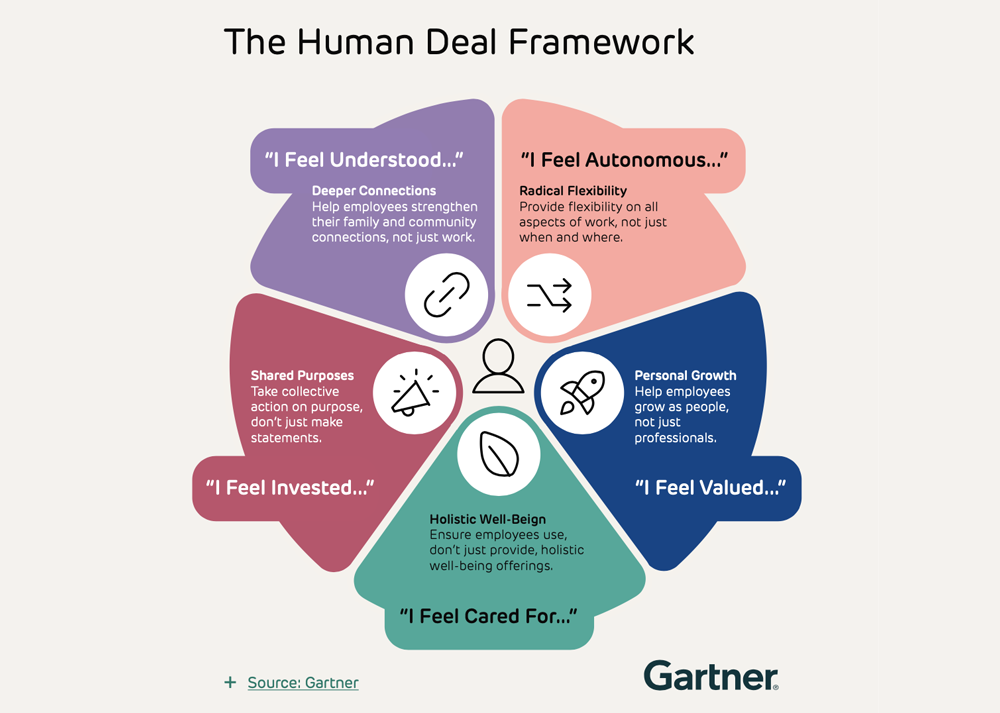As Suzanne Mehta at Cushman Wakefield writes:
“As we no longer need to “go to work” to be working, today’s office buildings need to serve as unique destinations that motivate and inspire people to go into the office; to connect with likeminded people, learn new things, feel connected with the brand and culture of their company and increasingly have access to amenities and services that support their life and wellbeing at work.”
What this looks like in practical terms will vary depending on an organisation’s goals, culture and values. It may encompass collaborative spaces, dedicated workstations, social spaces, green and outdoor spaces, lounges and relaxation areas. Amenities such as cafes, gyms, spaces to learn and connect, and even on-site childcare could be available.
By providing convenient amenities that can’t be easily replicated at home, the destination office provides a compelling reason for employees to travel and spend time in the workplace.
It creates an immersive experience that prompts positive relationships among colleagues and helps attract and retain top talent. It also helps employers demonstrate an understanding of employee needs, building positive relationships within the workplace and with the organisation.
The destination office concept can mean many things to many people. For us, it’s about creating moments that matter in the workplace and those stories of interaction, collaboration, and celebrating victories - these are the reasons that people come into our workplaces. It’s also about having community spaces that generate and showcase the culture of the company. Having spaces for hosting events and for our clients to come and innovate with us.
Lewis Barker, Director of Workplace Services EMEA at ServiceNow
Why Create a Destination Office?
In the short term, creating a destination office is about getting people excited about coming to work.
When you have a vibrant office space, you foster a strong company culture, encourage learning and promote the exchange of fresh ideas between teams. It’s a win-win for social and professional growth while also boosting staff wellbeing and morale.
Looking ahead, creating a destination office is about future-proofing your business. You want to attract and retain top talent in your industry, and that means providing spaces that nurture both productivity and happiness.
The demand for these kinds of environments is high. And the research shows us that when people like being in the office, it results in better outcomes for both employees and employers. Ultimately, investing in a destination office is an investment in your company’s success.
The 12 Pillars of a Destination Office
1. Wellbeing
A destination office promotes employee wellbeing by incorporating features that support physical and mental health, such as natural lighting, ergonomic furniture, green spaces, and wellness rooms. Art and other design elements could be incorporated to create a stimulating and inspiring environment. On-site gym facilities and fitness classes may also be available to employees to support their physical well-being.
Spaces for hobbies or personal development can transform the office into a place where workers can nurture well-rounded lifestyles, pursue their passions, and build connections with like-minded others.
2. Sustainability
A destination office embraces sustainability principles to minimise its impact on the environment. It incorporates eco-friendly practices, such as energy-efficiency lighting, waste reduction and recycling programs, sustainable materials and furniture, and green initiatives like rooftop gardens or solar panels.
By prioritising sustainability, the office demonstrates a commitment to environmental responsibility, aligning with employees’ growing concerns for a greener future.
The destination office may even pursue a BREEAM, LEED or SKA certification.
3. Amenities and Services
A destination office provides a wide range of amenities and services that enhance the employee experience. From on-site cafes and restaurants to fitness facilities, yoga studios, wellness rooms, childcare facilities, and dry cleaning services, the office becomes more than just a place to go to work but a place that merges work and lifestyle.
4. Technology Integration
A destination office seamlessly integrates technologies to improve the employee experience. This can include robust IT infrastructure, high-speed internet connectivity, video conferencing capabilities, collaborative tools and smart office systems that allow individual workers to book desks and control the lighting and temperature around them.
Technology integration enables efficient communication, hybrid collaboration, and seamless workflows, enhancing productivity and connectivity among employees, both within the office and with remote teams.
5. Design and Atmosphere
The physical environment of a destination office is carefully designed to create a positive atmosphere. It may feature natural lighting, biophilic elements, comfortable furniture, inspiring artwork and branding that reflects the company’s values and culture.
It also means moving away from cold colours that signal “it’s all business here”, to warmer neutrals with a nod to the natural world that provide a similar level of comfort to the home. These elements contribute to a welcoming and motivational ambience for employees.
6. Flexibility
Flexibility is critical to addressing occupancy fluctuation for hybrid work and is essential to the destination office. Flexibility is about more than just creating spaces for collaboration, individual work, socialising and learning. Workers need access to a range of meeting spaces, for example. Pods provide a quiet area away from distractions for a worker conducting a video call with a remote co-worker.
In contrast, meeting rooms and booths offer a space for active and generative meetings amongst in-person or distributed teams. Different teams will also use spaces in different ways. Some may engage in focus work at fully equipped workstations with high-performance task seating, while others may prefer to gather informally at a communal table. The office must support all these ways of working.
7. Inclusivity
In the destination office, spaces are planned with an inclusive design mindset, with diverse settings, a range of furniture and technology solutions, and attention paid to spatial perception and sensory control. Everyone should feel valued, productive and engaged from the moment they enter the office to the moment they leave.
8. Personal Space within the Communal Environment
Even in a flexible work environment, maintaining a sense of personal space is important. Lockers can play a pivotal role in facilitating this, bridging the gap between personal space and communal environments, offering employees a space to store their personal items and work-related materials securely. This means they can choose any available desk or workspace when they arrive.
Making the workspace their own also helps facilitate the sense of belonging. This could mean allowing employees to bring in plants or personal mementoes to make the space their own, as well as allowing them to control the space’s lighting, temperature, and privacy levels to suit their personal preferences.
9. Collaborative Spaces
A destination office should include designated areas for collaboration and teamwork, such as meeting rooms, project spaces, and open-plan areas that encourage employee interaction and knowledge sharing.
These spaces should be fitted with furniture that allows for a range of postures, from sitting and standing to leaning and perching, as well as seamless technology to display work, brainstorm ideas, and connect with remote teams.
10. Focused Workstations
Recognising the importance of individual concentration and productivity, the destination office should include designated workstations or quiet areas where employees can focus on tasks requiring deep concentration without distractions.
Pods, booths, and workstations separated by acoustic screens and panels give employees options to choose a space that suits them.
11. Social Spaces
To foster a sense of community and encourage social connections, the destination office should incorporate lounges, breakout areas, and communal kitchens where employees can relax, socialise, and build relationships with their colleagues.
Research shows that 65% of what employees learn comes from co-workers. And when people can connect and build relationships, it increases trust and gives people more confidence to take risks and be creative.
The more opportunities employees have to engage with others, the better it is for them and their employers.
In addition, amenities like gym facilities, fitness classes, or community gardens offer employees an opportunity to connect on a personal level outside of “work mode”, further strengthening bonds.
12. Learning Spaces
Learning spaces should be integral to the destination office, offering high-performing and adaptable environments that provide integrated learning opportunities for in-person and distributed groups.
These spaces demonstrate a commitment to continuous growth and development within the organisation.
They should have the right tools and technology to facilitate active engagement, collaboration and exploration.
Destination Offices Around the World
22 Bishopsgate, London, UK
“A mini-village office packed with amenities”
22 Bishopsgate is the largest commercial office development in London, boasting 1.3 million square feet across 62 floors, and was designed to promote community, interaction and employee wellbeing. The mini-village office features a wellness studio with a gym, fitness classes and meditation rooms, a food market, a fresh juice bar, and multiple gardens and outdoor terraces. The building is set up to support both individual work and collaboration, with various flexible workspaces, meeting rooms, and communal areas to socialise. It’s even 100% dog-friendly!
Also designed to be environmentally sustainable, it boasts green walls and roofs, a greywater recycling system, and an energy-efficient building management system. The building was developed by AXA IM - Real Assets, who see the building as a “blueprint for the future of office spaces” and an example of how workplaces can be designed to meet the evolving needs of employees.
The JJ Mack Building, London, UK
“London’s smartest and most sustainable building”
The JJ Mack Building is an exciting new development that hosts a range of amenities to make the workplace experience more enjoyable, including a rooftop terrace with views of the city, a cafe and restaurant, and a gym.
Labelled London’s smartest and most sustainable building, it’s packed with intelligent high-tech systems designed to improve employees’ well-being and enable a fully sustainable operation. It’s been rated BREEAM Outstanding.
The entire building’s performance can be tailored to the precise needs of the individual worker. A bespoke JJ Mack app gives workers touch-free access from the front door to their desks and allows them to set lighting and heating control to their preferences.
The building uses sensors to monitor the air quality and adjust ventilation accordingly, ensuring that employees have access to fresh, clean air at all times. The lighting system is also intelligent, using motion sensors to detect when rooms are occupied and adjust the lighting accordingly.
The building uses sensors to monitor the air quality and adjust ventilation accordingly, ensuring that employees have access to fresh, clean air at all times. The lighting system is also intelligent, using motion sensors to detect when rooms are occupied and adjust the lighting accordingly.
The Edge, Amsterdam, The Netherlands
“A smart building designed for wellbeing”
The Edge is renowned for its innovative design and advanced technology, earning the title of “the world’s most sustainable office building” when it opened in 2014.
The 40,000 square metre office space is designed for wellbeing, with natural lighting, indoor air quality sensors and personalised temperature controls. The building promotes a sense of community and collaboration with ample communal areas, cafes, and even a rooftop terrace with panoramic views.
These features combine to make it a unique and attractive destination office that motivates employees to come to work and enables them to be productive in a sustainable and healthy environment.
Alibaba Xixi Campus, Hangzhou, China
“An incubator for technology”
Alibaba’s global headquarters at its XiXi Campus is home to more than 20,000 employees. More than just a campus, it’s a hotbed for all things technology. Employees are inspired by new innovations being tested all the time, from self-driving cars to automated hotels. The on-site Alibaba museum features a history of the company’s growth adds to the experience.
Other amenities help to promote productivity and well-being. A central park and rooftop garden allow employees to relax and recharge. A state-of-the-art fitness centre, yoga studio and meditation room encourage employee health and wellness. Many restaurants and cafes also cater to employees’ diverse dietary needs and foster a sense of community.
The campus also features cutting-edge technology, including an AI-powered virtual assistant that can answer employee queries and control the building’s lighting and temperature. A mobile app also helps employees navigate their workday.
GooglePlex, California, USA
“A creative playground”
Google’s headquarters is known for its innovative design and extensive amenities. One of its most striking features is the innovative architecture, which includes a series of interconnected, colourful buildings and outdoor spaces that promote creativity and collaboration.
The campus boasts a range of facilities, including fitness centres with workout equipment and classes, basketball and volleyball courts, walking trails, parks, gardens, and cafes. Employee perks include free massages, haircuts and dry cleaning services. There’s even an extensive transport system, including shuttles, bikes and electric cars to help employees get around, adding to the overall experience.
Design Consultancy – Staff & Space Analysis
Interior Design
Inclusive Design
Prototype Spaces
Space Visualisation
Brand & Interior Graphics
Furniture & Accessories Specifications
Sustainable Stewardship
Budgetary Costings
Design Visualisation
Custom Furniture
Mock-ups / Pilots
Furniture Rental
Furniture Standards & Catalogues
Aftercare
Sustainable Office Clearance
Furniture Buy-Back Schemes
Asset Management and Furniture Audits
Furniture Refurbishment and Maintenance
Reuse / Repurpose Studies
Asset Audit and Tracking
Office Furniture Moves
Relocating IT Assets
Packing Services
Communication About Your Move
Storage
Moves and Churn




